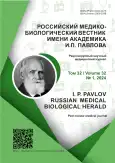Morphometric Features of Different Types of Bifurcations in the Splenic Intraorgan Arterial System in Individuals of Different Gender and Age
- Authors: Dadashev A.S.1, Zenin O.K.2, Miltykh I.S.2, Kafarov E.S.1
-
Affiliations:
- Kadyrov Chechen State University
- Penza State University
- Issue: Vol 32, No 1 (2024)
- Pages: 81-92
- Section: Original study
- URL: https://bakhtiniada.ru/pavlovj/article/view/254758
- DOI: https://doi.org/10.17816/PAVLOVJ321742
- ID: 254758
Cite item
Abstract
INTRODUCTION: A promising direction that has recently emerged in morphology is investigation of the arterial bed of various human organs as fractal or quasi-fractal systems. Conceptual models have been developed permitting a quantitative description of the vascular bed features. This approach will help to create a morphometric standard of the intraorgan blood flow, which will be useful in objective diagnosis of probable deviations from the normal structure.
AIM: To identify the morphometric features of various types of bifurcations of the splenic intraorgan arterial bed in individuals of different gender and age.
MATERIALS AND METHODS: The characteristics of the splenic intraorgan arterial bed have been studied in 67 individuals who died suddenly and from accidental causes at the age of 21 to 60 years. The arterial bed was represented as connected graphs with vertices corresponding to the bifurcation points of arteries, and edges to the arterial segments. The diameter and length of an arterial segment were measured on corrosion preparations. Based on the morphometry data, the following parameters were determined: generation number, division level, form factor FF1, branching factor ƞ and asymmetry factor γ. Statistical analysis was carried out using the R language.
RESULTS: The total number of examined arterial bifurcations was 6,840. The examined bifurcations were located at 20 division levels and presented 8 generations. In the structure of the vascular bed, bifurcations of neutral kind (0) predominated with the relative quantity 51%. The least numerous was type 2 bifurcations — 9%. The intermediate position was taken by open (1) bifurcations accounting for about 40% in the vascular bed structure.
CONCLUSIONS: The intraorgan arterial bed of the spleen is a quasi-fractal system consisting of three types of bifurcations — open, neutral and closed. A relative number of different types of bifurcations differs depending on gender and age and is also related to the generation number and division level.
Keywords
Full Text
##article.viewOnOriginalSite##About the authors
Ali Sh. Dadashev
Kadyrov Chechen State University
Email: mukulatura95@mail.ru
ORCID iD: 0000-0001-8502-0841
Russian Federation, Grozny
Oleg K. Zenin
Penza State University
Author for correspondence.
Email: zen.olegz@gmail.com
ORCID iD: 0000-0002-5447-1989
MD, Dr. Sci. (Med.), Professor
Russian Federation, PenzaIlia S. Miltykh
Penza State University
Email: contact@miltykh.com
ORCID iD: 0000-0002-9130-3255
Russian Federation, Penza
Edgar S. Kafarov
Kadyrov Chechen State University
Email: Edgar-kafaroff@yandex.ru
ORCID iD: 0000-0001-9735-9981
MD, Dr. Sci. (Med.), Professor
Russian Federation, GroznyReferences
- Standring S, editor. Gray’s anatomy. The anatomical basis of clinical practice. 42th ed. New York: Elsevier; 2021.
- Costi R, Ruiz CC, Romboli A, et al. Partial splenectomy: Who, when and how. A systematic review of the 2130 published cases. J Pediatr Surg. 2019;54(8):1527–38. doi: 10.1016/j.jpedsurg.2018. 11.010
- Redmond HP, Redmond JM, Rooney BP, et al. Surgical anatomy of the human spleen. Br J Surg. 2005;76(2):198–201. doi: 10.1002/bjs.1800760230
- Meisheri IV, Kothari PR, Kumar A, et al. Splenic artery embolisation for portal hypertention in children. Afr J Paediatr Surg. 2010;7(2): 86–91. doi: 10.4103/0189-6725.62854
- Dokoumetzidis A, Macheras P. A model for transport and dispersion in the circulatory system based on the vascular fractal tree. Ann Biomed Eng. 2003;31(3):284–93. doi: 10.1114/1.1555627
- Dovgiallo YuV, Beshulia OO, Tomash D.S. Conceptional models of tree-shape arterial bed structure. Aktual’nі problemi suchasnoї meditsini: Vіsnik ukraїns’koї medichnoї stomatologіchnoї akademії. 2009;9(4):47–9.
- Zenin OK, Miltykh IS, Dmitriev AV, et al. Morphometric analysis of C.D. Murray`s law appliance for numerical modeling of vascular dichotomies of kidneys. Siberian Journal of Life Sciences and Agriculture. 2021;13(3):170–92. (In Russ). doi: 10.12731/2658-6649-2021-13-3-170-192
- Kalpana R. A Study On Principal Branches of Coronary Arteries In Humans. Journal of the Anatomical Society of India. 2003;52(2): 137–40.
- Akhmedov VA, Shevchenko AS, Isaeva AS. Current view on the atherosclerosis emergence and progression factors. RMJ. Medical Review. 2019;(1):57–62. (In Russ).
- Zenin OK, Overko VS, Dmitriev AV, et al. Hemodynamic features in a structurally different arterial intraorganic bifurcations of the human heart by numerical modeling. Siberian Journal of Life Sciences and Agriculture. 2021;13(2):11–31. (In Russ). doi: 10.12731/2658-6649-2021-13-2-11-31
- Kafarov ES, Dmitriev AV, Zenin OK, et al. New X-ray contrast polymer composition for making anatomical corrosion preparations. Journal of New Medical Technologies, e-edition. 2021; 15(4):121–5. Available at: http://vnmt.ru/Bulletin/E2021-4/3-7.pdf. Accessed: 2023 March 29. (In Russ). doi: 10.24412/2075-4094- 2021-4-3-7
- Avtandilov GG. Osnovy kolichestvennoy patologicheskoy anatomii. Moscow: Meditsina; 2002. (In Russ).
- Stepanenko AYu. Asymmetry of the structure of the superficial vascular bed of the human cerebellum. Morphologia. 2017;11(2):46–51. (In Russ).
- Al-Kadi OS. Chapter 5. Fractals for Biomedical Texture Analysis. In: Depeursinge A, Al-Kadi OS, Mitchell JR, editors. Biomedical Texture Analysis. Fundamentals, Tools and Challenges. Academic Press; 2017. P. 131–61.
- Mandelbrot BB. The fractal geometry of nature. San Francisco: W.H. Freeman; 1982.
- Adams DL, Piserchia V, Economides JR, et al. Vascular Supply of the Cerebral Cortex is Specialized for Cell Layers but Not Columns. Cereb Cortex. 2015;25(10):3673–81. doi: 10.1093/cercor/bhu221
- Murray CD. The physiological principle of minimum work applied to the angle of branching of arteries. J Gen Physiol. 1926;9(6):835–41. doi: 10.1085/jgp.9.6.835
- Uylings HB. Optimization of diameters and bifurcation angles in lung and vascular tree structures. Bull Math Biol. 1977;39(5):509–20. doi: 10.1007/bf02461198
- Zamir M. On fractal properties of arterial trees. J Theor Biol. 1999;197(4):517–26. doi: 10.1006/jtbi.1998.0892
- Rozen R. Printsip optimal’nosti v biologii. Moscow: Mir; 1969. (In Russ).
Supplementary files











